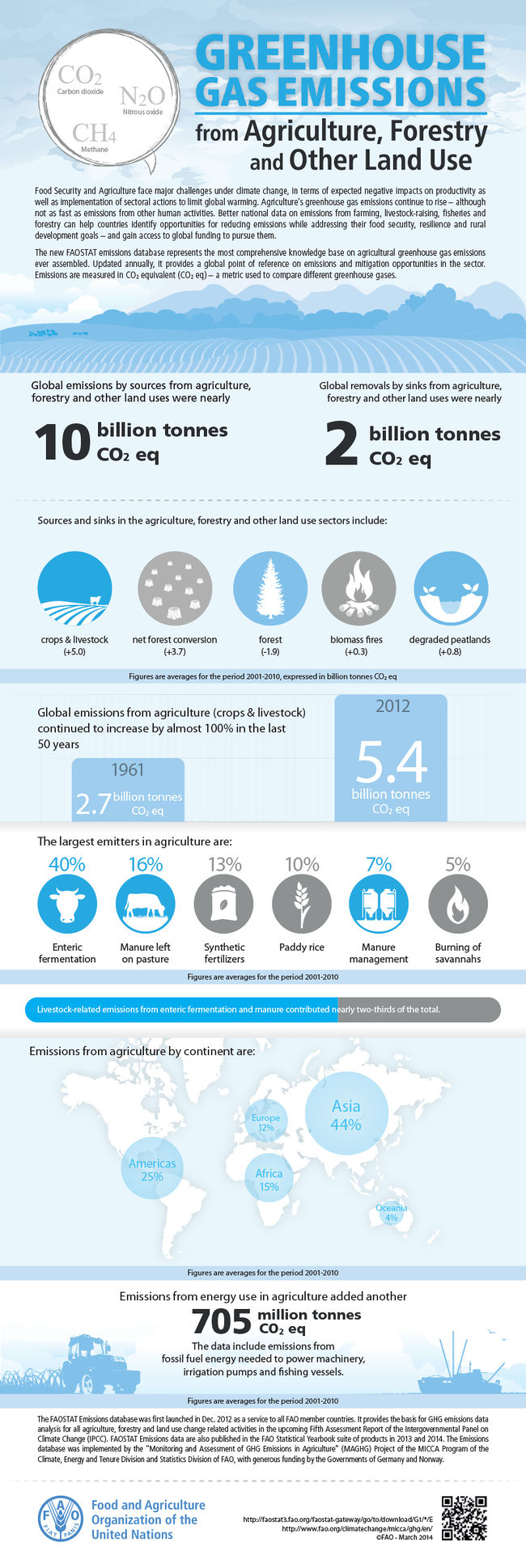Difference between revisions of "Greenhouse Gas Emissions from Agriculture"
***** (***** | *****) |
***** (***** | *****) m |
||
| Line 1: | Line 1: | ||
| − | |||
= Overview<br/> = | = Overview<br/> = | ||
| Line 44: | Line 43: | ||
*[[Greenhouse-Gas Emissions from the Production and Processing of Food|Greenhouse-Gas Emissions from the Production and Processing of Food]]<br/> | *[[Greenhouse-Gas Emissions from the Production and Processing of Food|Greenhouse-Gas Emissions from the Production and Processing of Food]]<br/> | ||
| − | *[[Portal: | + | *[[Portal:Water and Energy for Food|Water and Energy for Food (WE4F) portal on energypedia]] |
<br/> | <br/> | ||
| Line 52: | Line 51: | ||
<references /><br/> | <references /><br/> | ||
| + | [[Category:Climate_Change]] | ||
| + | [[Category:Agriculture]] | ||
[[Category:Powering_Agriculture]] | [[Category:Powering_Agriculture]] | ||
| − | |||
| − | |||
Latest revision as of 19:15, 14 July 2020
Overview
The FAO has compiled data regarding greenhouse gas emissions (GHG) from agriculture, forestry and other land use. Food Security and Agriculture have to face substantial challenges under climate change: Negative impacts on productivity are expected, while sectoral actions need to be implemented to limit global warming.
Nontheless, greenhouse gas emissions from farming, livestock-raising, fisheries and forestry continue to rise (though not as fast as emissions from other human activities). Data on agriculture's emissions can help countries identify opportunities for reducing emissions while addressing their food security, resilience and rural development goals. Further, better data can help countries to gain access to global funding to pursue them.
"The new FAOSTAT emissions database represents the most comprehensive knowledge base on agricultural greenhouse gas emissions ever assembled. Updated annually, it provides a global point of reference on emissions and mitigation opportunities in the sector. Emissions are measured in CO2 equivalent (CO2 eq) – a metric used to compare different greenhouse gases."
Greenhouse Gas Emissions from Agriculture
The FAOSTAT Emissions Agriculture database provides country-level estimates of GHG emissions based on FAOSTAT activity data and using Tier 1 computations, following 2006 Intergovernmental Panel on Climate Change (IPCC) Guidelines for National Greenhouse Gas Inventories.
One infographic displays the most relevant data (further detailed data can be found in the database):
Source: Fao.org
Mitigating Greenhouse Gases in Agriculture
Another article by Muller, Jawtusch and Gattinger[1] sheds light on the mitigation potential of agriculture. As the political framework is key to fostering a more climate friendly agriculture, the authors analyse policies at national and international levels, referring to case studies from Brazil (meat, fodder and biomass producers and climate change), Indonesia (rice production and climate change) and the European Union. They argue that there is need for combined approaches from climate policy and agricultural policy, addressing the specific characteristics of the agricultural sector.
They present five main goals which policies for climate friendly agriculture should focus on:
- Increase soil carbon: While this is not permament and has saturation dynamics, increasing soil carbon levels could substantially contribute to gain time for stringent and permanent mitigation actions in agriculture.
- Realise closed nutrient cycles in agriculture: Nutrient recycling is crucial for increasing soil carbon levels. Closed nutrient cycles have advantages regarding nitrogen as well as non-renewable nutrients such as phosphorus.
- Change of consumption and waste patterns: Changes in consumption patterns are absolutely necessary for a climate friendly agriculture (e.g. reduction of meat consumption, acceptance of resistant and locally adapted varieties). Consumer patterns directly influence energy use (e.g. seasonal and local products reduce emissions). Storage losses in developing countries could be avoided with improved infrastructure, while in developed countries food waste of the end product needs to be reduced i.e. the consumer behaviour needs to change.
- Improve scientific knowledge in nitrous oxide dynamics: The details of nitrous oxide emissions need to be better understood, particulary the emissions from various types of organic fertilizers and green manures and how to optimally apply them. Further, more knowledge is needed of site-specific parameters on emissions.
- Develop methods for the optimal assessment of complex, multi-functional farming systems: There is a need for quantifying emissions and sequestration in the context of climate friendly agriculture. Conceptual work is needed on how to best assess agricultural systems with various outputs and services in the context of mitigation.
The article provides a detailed overview of mitigation measures in agriculture and their indicative mitigation potential, also indicating sources for further information.
You find the entire article here.
Further Articles
- Greenhouse-Gas Emissions from the Production and Processing of Food
- Water and Energy for Food (WE4F) portal on energypedia
References
- ↑ Muller, Adrian; Jawtusch, Julia and Gattinger, Andreas (2011) Mitigating Greenhouse Gases in Agriculture. Diakonisches Werk der EKD e.V. for Brot für die Welt.




















